Enermax ETS-T40-VD CPU Cooler Review
Luke Hill / 13 years ago
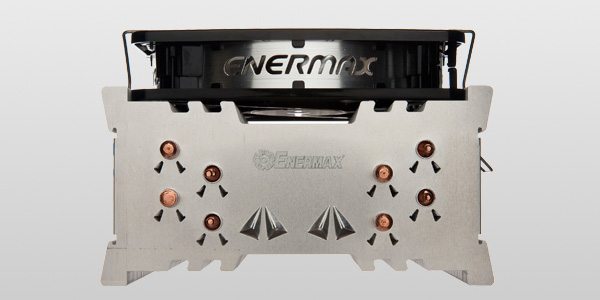
Enermax have decided to take a daring entry into the CPU cooler market. Their debut line-up consists of a tower style cooler and a top-down style, low profile variant. A pair of actual heatsinks creates the line-up but Enermax have intelligently created 5 different products by bundling the tower style ETS-T40 with 3 different fan variations and the top-down style ETS-T60 with 2 unique fan configurations. Today, we will be looking at the tower style ETS-T40-VD which is bundled with Enermax’s extremely popular Vegas Duo fan. Be sure to keep an eye out for our review of the ETS-T60-VD soon!
The ETS-T40-VD is built around a single tower design consisting of 4 direct touch, 6mm copper heatpipes and an aluminium fin array. Enermax claim to have reached a “New Milestone” with their heatsink’s 0.09°C/W thermal resistance. The 3 innovations responsible for this value of thermal resistance are Enermax’s patented Stack Effect Flow (SEF), Vortex Generator Flow (VGF) and Vacuum Effect Flow (VEF). A single 120mm Enermax TB Vegas Duo fan is bundled with the ETS-T40-VD which utilizes the 4-pin PWM connector and is capable of reaching 1800 RPM while shifting up to 76 CFM of air.
Compatibility comes in the form of support for every modern Intel and AMD socket other than LGA 2011. At 160mm in height and weighing around 610g for the cooler alone, Enermax’s ETS-T40 cooler range should fit perfectly in most mid tower and above cases. Enermax have also included an extra pair of fan clips for enthusiasts who want to unlock every ounce of potential from the ETS-T40 heatsink.
With a retail price of around £37/€35 for the Vegas Duo version or less than £30/€30 for versions equipped with different fans, Enermax could have a CPU cooler which brings the aesthetic appeal to the table, but leaves the extortionate price tag behind.
The ETS-T40-VD is supplied in bright packaging, the front of which features a picture of the cooler itself and various fan offerings. Enermax claim a 200+W heat tolerance, but will our tests show otherwise?
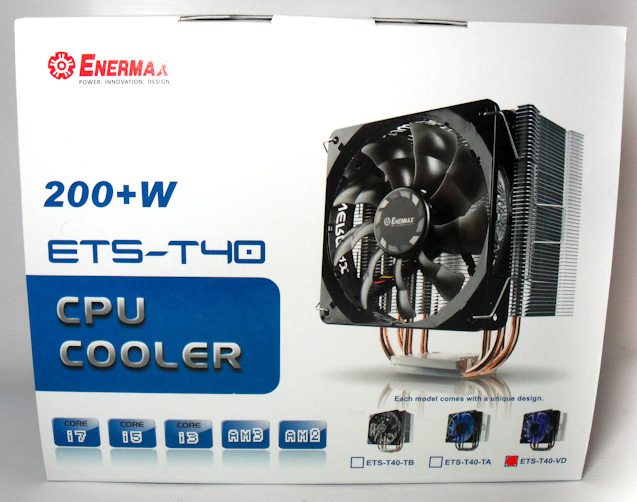
Features outlined on the rear of the box include the patented trio of thermal resistance enhancing innovations, fan attributes, compatibility and annotated images.
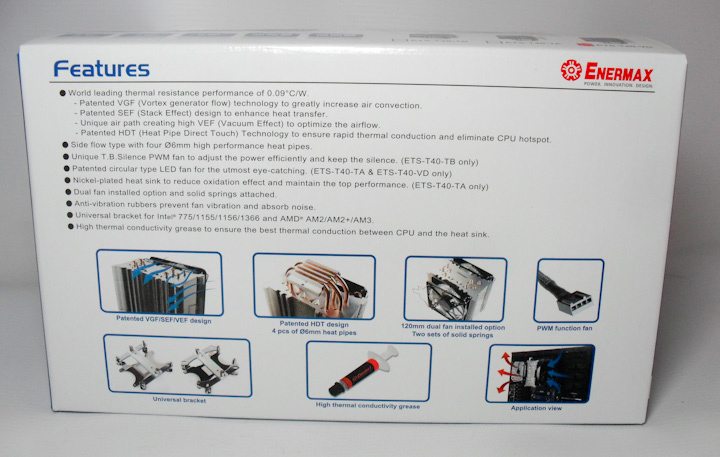
Moving around to the right of the packaging, we are met by the package contents as well as a picture of all 3 CPU cooler variants accompanied by a sticker showing which one you possess.
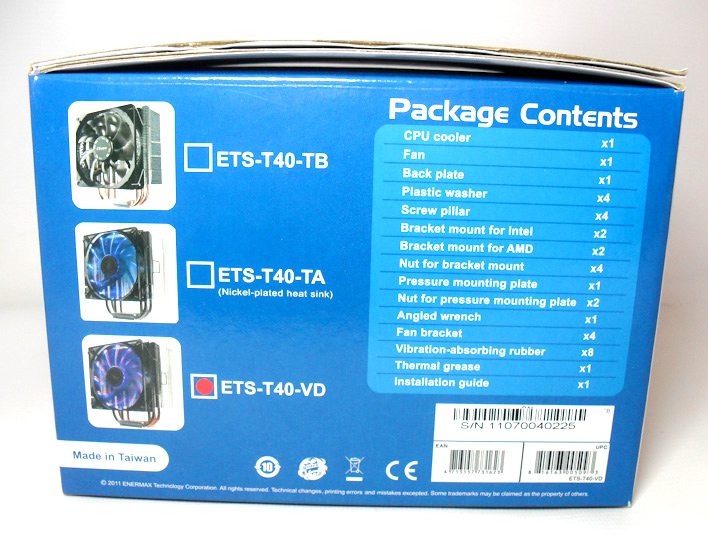
Detailed heatsink and fan specifications, including dimensions, are located on the left side of the Enermax ETS-T40-VD’s box.
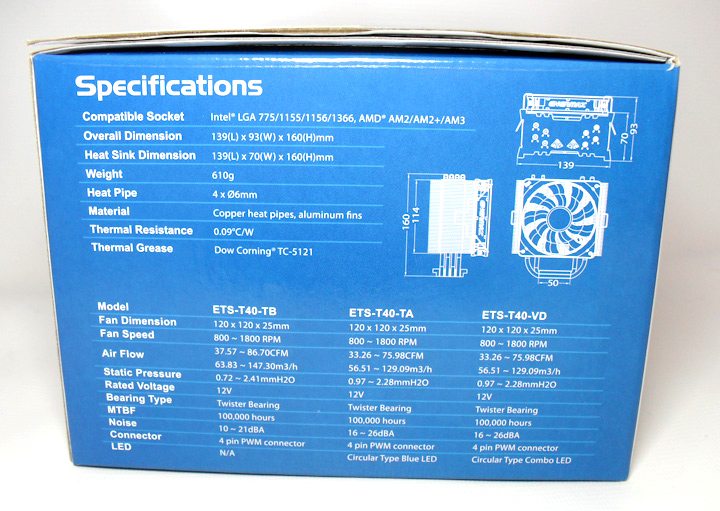
The supplied accessories include 2 pairs of fan clips opening up the possibility of a push/pull configuration, a tube of Dow Corning TC-5121 thermal grease, the universal backplate, Intel and AMD mounting hardware and an extra 4 rubber anti-vibration dampers for use with an additional fan.
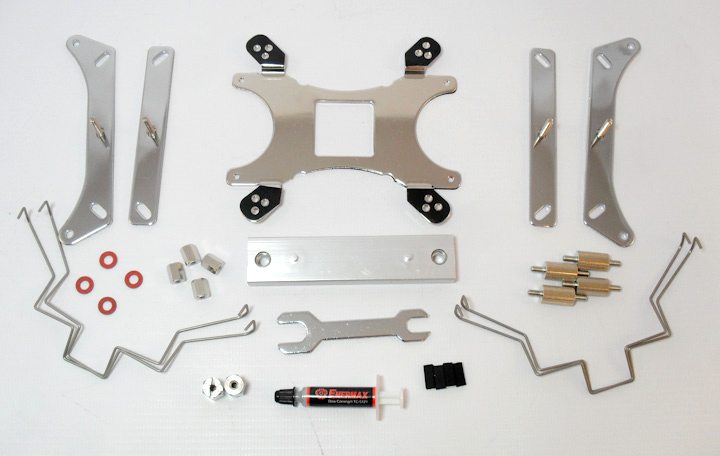
The black & white user manual supplied by Enermax seems to be informative and straightforward to follow. We will have to find out whether this is the case or not.

The ETS-T40 heatsink itself stands 160mm tall and 139mm wide. An intriguing fin array layout is used by Enermax which can be thought of as the catalyst to many of their alleged thermal resistance innovations.

The multiple grooves and channels will cause the airflow to become more turbulent while also increasing its pressure. The 4 strategically positioned gaps beneath the Enermax logo, on the summit of the cooler, are designed to allow an escape point for the rising hot air which will then, in turn, draw in additional cool air. Both of these innovative designs should, in theory, improve the effectiveness of the air’s heat transfer and dissipation.

The quartet of 6mm copper heatpipes converges to form a heatpipe direct touch (H.D.T.) base. The H.D.T. base should be capable of removing heat quickly from a CPU, but perhaps the quoted 200+W heat extraction potential is a little optimistic for this design to retain acceptable performance.  A pair of fan clips attaches the 120mm TB Vegas Duo fan to the heatsink at a user-defined height. Anti-vibrations rubber dampers on each corner of the fan should that ensure noise levels are kept to a minimum.
A pair of fan clips attaches the 120mm TB Vegas Duo fan to the heatsink at a user-defined height. Anti-vibrations rubber dampers on each corner of the fan should that ensure noise levels are kept to a minimum.

The supplied Anti-vibration noise reducing dampers can be easily attached to a wide variety of fans including Scythe’s AP-15s.

The universal, metal backplate is quite awkward to attach to our motherboard as the screws which hold it in place are fastened from the motherboard’s front side.

A pair of metal bracket mounts allows flexibility as to the orientation of an Intel installation.

A very sturdy, metal pressure mounting plate secures the cooler in position by being firmly fastened to the metal bracket mounts below as well as the cooler itself.

Motherboard component interference shouldn’t be a major issue with the Enermax ETS-T40-VD. Its width may cause slight interference issues with an expansion card mounted in the uppermost expansion slot as the fan clip does stray from the heatsink itself.

RAM interference is relatively non-existent thanks to the ETS-T40’s high fin array positioning and flexible fan mount.

The ETS-T40-VD fits nicely in our NZXT Phantom case with plenty of room to spare. The 4-pin PWM fan cable is slightly tricky to hide, but seeing as it is braided black, ugliness isn’t a huge issue. The other cable attached to the fan is actually an LED control switch. Its length is sufficient for you to route it out of your case, allowing your control the LED colour and revolution speed while your system is in use.

We decided to compare the Enermax ETS-T40-VD against 7 other CPU coolers from a variety of price ranges that we have previously had experience with.
Testing method:
- Stable recorded CPU temperatures from a 15 minute idle test
- Stable recorded CPU temperatures from a 15 minute load test
- The cooler’s fans are set at 100% speed unless otherwise stated
- All tests are repeated to check the consistency and reliability of the results
- Delta temperatures are used in the charts to provide more accurate results
- Maximum recorded noise output at 100% fan speed
- The supplied thermal paste is always used to make the results a fair interpretation of the cooler’s stock performance
- The temperature threshold we set before calling the test a fail is 65oC above ambient but if the cooler manages to complete more than 75% of the test before rising above the 65oC delta mark, we allow it to complete the test, provided it is capable
- A +/- 1 degree Celsius margin of error is incorporated by our CPU/GPU temperature recording method
- A +/- 0.1 degree Celsius margin of error is incorporated by our ambient temperature recording method
Test system:
- MSI P67A-GD65
- Intel Core i7 2600K
- 4GB DDR3 1600MHz
- XFX Radeon HD 4870 1GB
- 128GB Kingston SSDnow V100 (OS)
- Corsair TX650
- NZXT Phantom Case
- Supplied Dow Corning TC-5121 thermal paste
Comparison used:
- Phanteks PH-TC14PE
- Corsair H80
- Cooler Master Hyper 212 Plus
- Cooler Master V6GT
- Gelid Tranquillo Rev. 2
- Xigmatek Aegir SD128264
- Cooler Master Hyper 612S
- Enermax ETS-T40-VD with Scythe AP-15 fans push/pull
Software used:
- Windows 7 Professional 64-bit
- HWMonitor
- Prime95
Measuring temperatures is all about being consistent; therefore we make sure that the test is kept completely fair so that none of the coolers are at a disadvantage. We measure the CPU temperature using HWMonitor after a 15 minute idle period. We then measure the CPU temperature using HWMonitor after a 15 minute load period using Prime95 with the small FFTs setting.
The chart shows the delta CPU temperature (difference between ambient temperature and recorded CPU temperature). This way we can fairly compare each cooler without presenting any inaccuracies due to slight fluctuations in the ambient temperature or unfair results.
Here is an example of how to understand delta temperatures. “If the ambient (room) temperature is 25C and the recorded CPU temperature is 65C, the delta temperature is the CPU’s temperature rise above ambient temperature, therefore the delta temperature in this case would be 40C. If the ambient temperature is 23C and the recorded CPU Temperature is 80C, the delta temperature in this case would be 57C. Delta temperature = Recorded CPU temperature – Ambient temperature”

Enermax’s ETS-T40-VD shows decent performance while our Intel Core i7 2600K test CPU is operating at stock frequency. The cooler manages to near the performance of Xigmatek’s similarly priced Aegir SD128264 and Cooler Master’s ageing, but still competitive V6GT. Yet again, Cooler Master’s Hyper 212 Plus proves its ability to punch well above the weight its price tag suggests by managing to narrowly beat the more expensive ETS-T40-VD.
We repeated the testing procedures with our Intel Core i7 2600K CPU overclocked to 4.4GHz using a BIOS voltage of 1.240V which crept up to a maximum of 1.288V under load conditions. We must remind you that we have discovered our processor runs slightly hotter than usual, but seeing as all tests use the same CPU, the results aren’t biased.

Once a 4.4GHz overclock is thrown into the mix, similar observations to the stock frequency results are present. The ETS-T40-VD trails the Aegir SD128264 by a narrow margin while it manages to widen its lead against Gelid’s Tranquillo Rev. 2. Both Cooler Master alternatives in the Hyper 212 Plus and V6GT start to flex their muscle by increasing their lead over the Enermax. The similarly priced V6GT now starts to show a noticeable performance difference.
We will repeat the load tests with our CPU at stock speed and overclocked, but this time we will use high powered 1850RPM Scythe AP-15 fans in push-pull configuration when possible. This test will show the heatsink’s true potential with fans that perform excellently on heatsinks and radiators. It will also outline whether or not the bundled fans are offering acceptable performance.

Using a pair of Scythe 1850 RPM Gentle Typhoon AP-15 fans yields a slight performance increase, which is of questionable value when taking the price increase into consideration. Another point in favour of Enermax’s supplied offering is that the AP-15s don’t offer the tremendous aesthetic appeal which is present on the Vegas Duo fan. The 4-pin PWM connector used on the Enermax fan is also hugely useful.
While situated in a room where background noise was kept to a minimum, we placed the sound level meter equal distances from our test system to measure the total noise output by the complete test system for each cooling configuration at 100% fan speed.

Now the ETS-T40 really starts to shine. The pleasantly low acoustic output is of great value when coupling it with the competitive performance. Even the pair of AP-15 fans can only shave a small amount off the standard configuration’s acoustic value.
The target audience for Enermax’s ETS-T40-VD are users who want to cool their overclocked CPU effectively while also having a stylish and trendy looking cooler.
Focusing on the cooling performance in comparison to the competitors, the ETS-T40-VD falls right where we would expect it to. The performance is similar to that of Xigmatek’s SD128264 Aegir, slightly behind Cooler Master’s mighty V6GT and better than Cooler Master’s Hyper 612S. All 4 of these particular coolers retail for a similar price, so the performance can’t be considered revolutionary or class-leading, but it isn’t disappointing either. One point worth noting though is that we are reviewing the most expensive version of the ETS-T40 series which is bundled with the 120mm Enermax TB Vegas Duo fan. There are 2 cheaper versions available which use the exact same heatsink and will offer a better ‘bang for buck’ factor.
The installation was predominately painless with just the few awkward areas. Backplate attachment had us begging for a third hand, but other than that, we didn’t run into any hiccups. Once installation was complete, the mount was very stable and interfered with hardly any of the neighbouring components.
Appealing aesthetics are equally as important to the ETS-T40-VD as its cooling performance. The attractive design is tied together with the use of one of the most eye-catching fans around in Enermax’s own TB Vegas Duo. The wide range of LED colours and manoeuvres are certain to interest enthusiasts who use a case with a side panel window and love to show off their attractive system. Enermax cover every aspect of making the cooler look amazing by using a black braided cable on the fan and even giving users an external method of changing the LED colours and manoeuvres via a button wired to the fan.
As far as balanced CPU cooler offerings go, Enermax have one of the market’s high-rollers in the ETS-T40-VD. It retails at a fairly competitive price, offers good performance against some of its similarly priced competitors and looks absolutely stunning. Not only does it have all of those positive points in its locker, its acoustic output is also very low, lower than the majority of its main competitors. Some of you may consider the ETS-T40-VD variant slightly overpriced, but if that is the case, the cheaper ETS-T40-TA or ETS-T40-TB variants should suit you down to the ground.
Enermax have made a commendable first outing into the particularly competitive CPU cooler market. Their £37 ETS-T40-VD cooler offers good performance, a fairly competitive price tag, astounding appearance and low noise operation. The cooler is a good all-rounder, but doesn’t excel particularly in an area other than aesthetics. For this reason, we feel the Enermax ETS-T40-VD deserves a well-earned eTeknix ‘Innovation award’. Hopefully, this is the first of many impressive products to come from Enermax’s CPU cooling department.




















